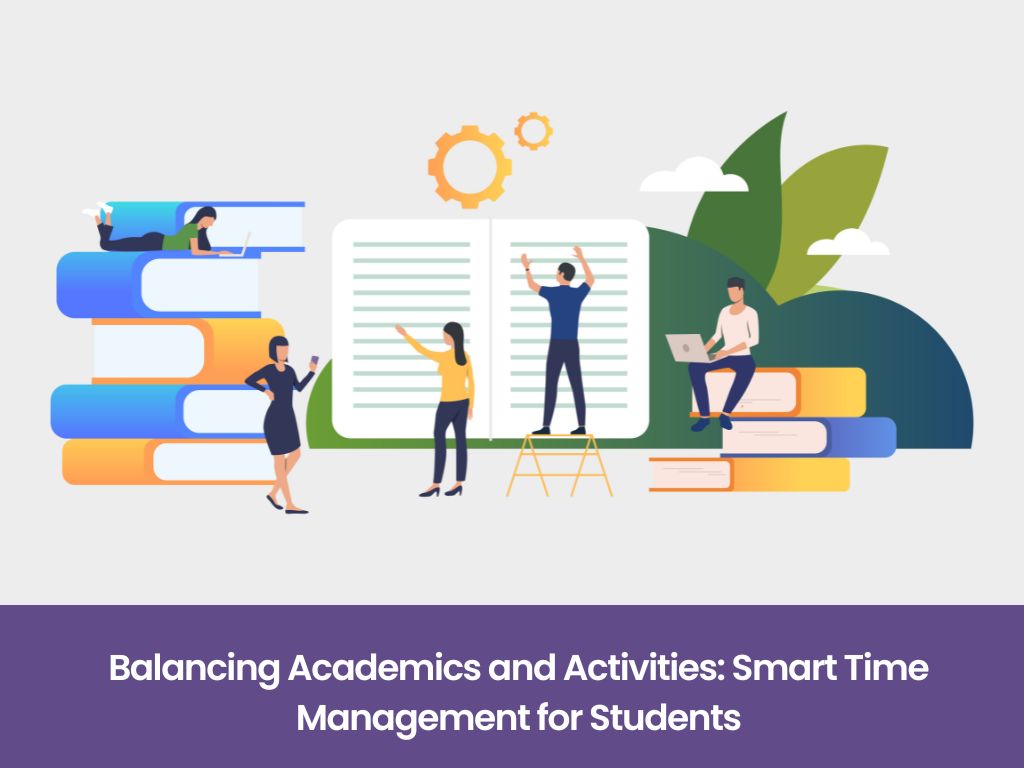Balancing Academics and Activities: Smart Time Management for Students
posted on Oct 13, 2025
Learn how students can balance academics and extracurricular activities effectively with practical time management strategies for success and stress-free learning.

Introduction
In today’s dynamic educational landscape, students are expected to juggle multiple responsibilities — from completing academic assignments and preparing for exams to participating in sports, arts, clubs, and community activities. While these experiences enrich learning, the real challenge lies in maintaining balance. Time management has become one of the most vital life skills for students striving to succeed both in and outside the classroom.
Balancing academics and extracurricular activities not only helps students excel academically but also nurtures their creativity, leadership, and social skills. However, without a proper plan, students can easily feel overwhelmed. This blog explores the importance of balance, effective time management techniques, and how schools and parents can support children in managing their responsibilities effectively.
Why Balancing Academics and Activities Matters
A well-balanced approach between academics and activities helps students grow holistically. Academic success builds knowledge, discipline, and focus, while extracurricular pursuits develop teamwork, communication, and emotional intelligence.
Students who actively engage in both spheres often display higher motivation, better problem-solving skills, and stronger emotional resilience. They learn how to manage priorities, set goals, and stay organized — skills that go beyond the classroom and prove invaluable in future careers.
However, imbalance can lead to stress and burnout. Overemphasizing academics can suppress creativity and social growth, whereas prioritizing only activities may impact grades and academic goals. Thus, striking the right equilibrium ensures a student’s overall well-being and sustained performance.
Challenges Students Face
While balance is essential, achieving it is not always easy. Some common challenges include:
-
Overcommitment: Students often take on too many clubs or classes, leaving little room for rest or revision.
-
Lack of Prioritization: Without clear priorities, students may end up spending more time on less productive activities.
-
Procrastination: Delaying tasks can result in last-minute stress and decreased productivity.
-
Distractions: Social media, peer pressure, and digital entertainment can easily derail focus.
-
Poor Scheduling: Not planning ahead can lead to missed deadlines and unnecessary anxiety.
Recognizing these challenges is the first step toward effective time management. Once students are aware of what holds them back, they can adopt techniques to overcome them.
Smart Time Management Strategies
To effectively balance academics and activities, students need a structured approach. Here are some proven strategies:
1. Set Clear Goals
Having specific goals for both academics and extracurriculars gives direction and purpose. Whether it’s achieving a target grade or improving in a sport, goals help students stay motivated and track progress.
2. Plan a Weekly Schedule
A well-organized planner can transform a busy week into a productive one. Students should allocate fixed time blocks for studying, sports practice, hobbies, and rest. Using tools like Google Calendar or planner notebooks helps in visualizing time commitments.
3. Prioritize Tasks
Not all tasks are equally important. The Eisenhower Matrix — dividing tasks into urgent, important, and non-essential — helps students identify what deserves immediate attention versus what can wait.
4. Avoid Multitasking
Though it may seem efficient, multitasking often reduces concentration and quality. Focusing on one task at a time improves efficiency and comprehension, especially during study sessions.
5. Take Regular Breaks
Short breaks between study periods rejuvenate the brain and prevent burnout. Techniques like the Pomodoro Method — studying for 25 minutes followed by a 5-minute break — can enhance productivity.
6. Learn to Say No
Students must recognize their limits. It’s okay to decline certain activities if the schedule becomes too hectic. Quality of participation always outweighs quantity.
7. Seek Support from Teachers and Parents
Open communication with teachers and parents helps in adjusting workloads and identifying areas of stress. Mentors can offer valuable guidance on balancing expectations.
The Role of Schools in Encouraging Balance
Schools play a significant role in shaping how students manage time. By promoting structured routines, balanced timetables, and holistic development, institutions can help students thrive.
At BGS Vijnatham School, one of the Best School in Greater Noida West, educators emphasize the importance of time management through an integrated curriculum. The school ensures students experience both academic excellence and extracurricular enrichment without feeling overwhelmed. Through counseling, co-curricular programs, and skill-based workshops, children learn how to plan their time effectively while pursuing their passions.
This kind of supportive ecosystem helps students cultivate self-discipline and balance — preparing them not just for exams but for life beyond school.
Balancing Study Time and Play Time
A common misconception among students is that more study time automatically means better results. In reality, balance is key. Students who dedicate time to sports, music, or art often return to academics with greater focus and energy. Physical activities enhance brain function, while creative outlets improve problem-solving and emotional regulation.
Playtime also provides an opportunity to develop social skills and resilience — qualities that complement academic intelligence. Therefore, instead of viewing extracurricular activities as distractions, students should see them as essential elements of holistic growth.
Digital Tools That Help
Modern students can leverage technology for better time management. Productivity apps like Todoist, Notion, and Google Tasks help organize assignments and deadlines.
However, balance in technology use is also crucial. Digital overload can harm concentration, so students should set screen time limits and use devices intentionally rather than excessively.
Conclusion
Balancing academics and activities isn’t about doing everything at once — it’s about doing what matters most, efficiently and joyfully. With strong planning, discipline, and the right mindset, students can excel in both academics and extracurriculars without feeling overburdened.
By learning to manage time early, students prepare themselves for future academic, professional, and personal success. As schools and parents encourage holistic development, the ability to balance priorities becomes one of the greatest strengths a child can develop — turning them into well-rounded individuals ready to thrive in an ever-evolving world.